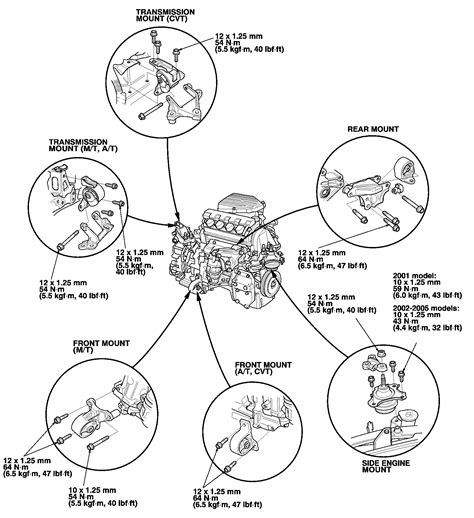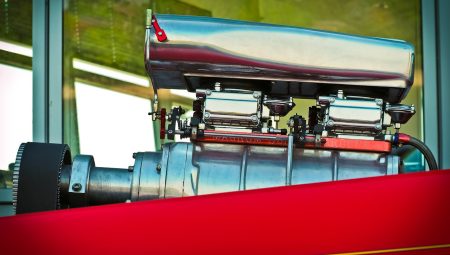Explore the essentials of engine mounts: types, functions, diagrams, and common problems to ensure your vehicle runs smoothly and efficiently.When it comes to the smooth operation of your vehicle, engine mounts play a crucial yet often overlooked role. These components serve as the vital link between the engine and the chassis, ensuring stability and minimizing vibrations. In this blog post, we’ll delve into the world of engine mounts, exploring their various types and functions, while offering a comprehensive breakdown of an engine mount diagram. Understanding how these parts work together can illuminate the common issues that may arise, helping car owners diagnose problems early on. Whether you’re a seasoned mechanic or just curious about your car’s anatomy, this guide will equip you with the knowledge to appreciate the importance of engine mounts in your vehicle’s performance and longevity.
Understanding Engine Mounts
Engine mounts, also known as engine support or engine insulators, play a critical role in maintaining the integrity and functionality of a vehicle’s engine system, as they are essential components that serve to secure the engine to the vehicle’s chassis while simultaneously absorbing vibrations and shocks produced during the engine’s operation, which helps to ensure that the driving experience remains smooth and comfortable.
The importance of engine mounts cannot be overstated, as they not only help in reducing the transfer of vibrations from the engine to the car’s frame but also contribute to the overall stability of the engine, which is crucial for the efficient operation of various vehicle systems, such as the transmission and exhaust, while also assisting in the alignment of the engine with other important components such as the drivetrain.
Moreover, understanding the various types of engine mounts available—be it rubber, polyurethane, or hydraulic—and recognizing their respective functions can significantly influence the longevity of the vehicle’s performance and safety, as each type offers distinct features designed to cater to different driving requirements and engine characteristics, thus ensuring that the vehicle operates smoothly under various conditions.
Types of Engine Mounts
When considering the types of engine mounts, it’s essential to recognize that they serve the crucial purpose of securing the engine to the vehicle’s frame while also isolating vibrations and noise produced by the engine during operation. Within the realm of engine mounts, one can distinguish several key categories that are commonly used in various automotive applications, each designed with distinct characteristics and benefits tailored to specific needs.
One prominent type of engine mount is the rubber engine mount, which is widely favored for its ability to absorb vibrations effectively due to the inherent elasticity of rubber, allowing for a smoother ride while minimizing the transfer of engine noise into the cabin of the vehicle; however, they can wear down over time, necessitating regular inspections and replacements to ensure optimal performance.
Another noteworthy category is the hydraulic engine mount, which employs a fluid-filled chamber to dampen vibrations and provide enhanced stability, offering superior cushioning compared to traditional rubber mounts; these mounts are particularly beneficial in high-performance vehicles where engine movement can severely impact vehicle handling, thus they are engineered to withstand more significant forces and pressures.
| Type of Engine Mount | Key Feature | Common Applications |
|---|---|---|
| Rubber Engine Mount | Vibration absorption | Standard vehicles |
| Hydraulic Engine Mount | Fluid cushioning | Performance vehicles |
| Solid Engine Mount | Maximum support | Racing vehicles |
Additionally, there are solid engine mounts, which are crafted from materials that provide maximum support and stability, making them ideal for racing vehicles where minimal engine movement is desired for enhanced control and performance, yet these mounts may transmit more vibrations into the cabin, thus making them less suitable for everyday driving conditions.
As a final point of consideration, the choice of engine mount fundamentally affects not only the performance of the vehicle but also the driving experience, as each type brings its own set of advantages and drawbacks, thereby emphasizing the importance of selecting the right engine mou
Function of Engine Mounts
Engine mounts, which are critical components in a vehicle’s design, serve essential functions that significantly contribute to the overall performance, safety, and comfort of a vehicle, as they are responsible for securing the engine to the vehicle’s chassis while simultaneously isolating vibrations and noise produced by the engine during operation.
In addition to providing structural support, engine mounts facilitate the controlled movement of the engine, allowing it to shift slightly under various loads, which is important during acceleration, braking, and cornering, thus preventing undue stress on the engine components and drivetrain.
Moreover, the design of engine mounts often incorporates rubber or polyurethane materials, which not only help in reducing the transmission of vibrations from the engine to the cabin of the vehicle but also absorb shock loads that the engine experiences, ultimately resulting in a smoother driving experience and extending the lifesp
Engine Mount Diagram Breakdown
The engine mount diagram serves as an essential visual aid for understanding the structural support provided to the engine in a vehicle, highlighting how the mounts secure the engine to the vehicle’s chassis while also dampening vibrations that would otherwise transfer through to the cabin.
Typically, an engine mount comprises several components, including rubber or polyurethane bushings, a metal bracket bolted to both the engine and the frame, and sometimes an additional hydraulic fluid reservoir designed to absorb shocks and vibrations, which can significantly enhance ride comfort and prolong the lifespan of engine-related components.
In the engine mount diagram, you may observe a variation in design elements based on vehicle models; however, the fundamental layout usually features the engine positioned atop the mounts, which are symmetrically located to maintain balance, as well as labels identifying each part, showcasing how the function of engine mounts is crucial for stability, vibration control, and noise reduction.
Common Engine Mount Problems
Engine mounts play a crucial role in the smooth operation of a vehicle by securing the engine to the chassis and minimizing vibrations; however, over time and with consistent usage, these mounts can encounter several problems that compromise their effectiveness, leading to issues that can negatively affect the driving experience and the vehicle’s overall performance. One of the most common signs that an engine mount is failing is an increase in engine vibrations that can be felt through the steering wheel and the vehicle’s floor, indicating that the mount is no longer effectively dampening the force of the engine’s operation.
Additionally, you may notice unusual engine movement, especially when accelerating or decelerating, which might manifest as a noticeable rocking motion of the engine that can be felt inside the cabin, suggesting that the engine mount has deteriorated or broken, thus failing to keep the engine securely in place. Another serious issue that often arises is the presence of oil leaks around the engine mount area; this can occur if the mount’s rubber components become damaged or cracked, leading to fluids escaping and creating a potential fire hazard if not addressed promptly.
Lastly, if you observe any audible noises such as clunks or thuds when shifting gears or driving over bumps, it could be a clear indicator that the engine mount is failing, as these noises can be caused by excessive engine movement or contact with other engine components. It’s essential to address these common problems quickly to ensure the continued safety and functionality of your vehicle, as neglecting these symptoms can lead to more seve
Frequently Asked Questions
What is an engine mount diagram?
An engine mount diagram is a visual representation that illustrates the various components and configurations of engine mounts in a vehicle. It shows how the engine is secured to the chassis and how the mounts are arranged.
Why are engine mounts important?
Engine mounts are crucial as they secure the engine in place, reduce vibrations, and maintain proper alignment. They also help absorb shocks during driving, contributing to a smoother ride.
What materials are commonly used for engine mounts?
Engine mounts are typically made from rubber, metal, or a combination of both. Rubber helps absorb vibrations while metal provides strength and durability.
How can I tell if my engine mounts need replacing?
Signs that engine mounts may need replacing include excessive engine vibrations, visible cracks or damage on the mounts, unusual noises when accelerating or decelerating, and misalignment of the engine.
Can I replace engine mounts myself?
Yes, replacing engine mounts can be a DIY project if you have basic mechanical skills and the right tools. However, it can be labor-intensive and requires safety precautions, so it’s important to assess your comfort level before attempting this task.
What tools do I need to replace an engine mount?
Common tools needed to replace an engine mount include a jack and jack stands, socket set, wrenches, and potentially a torque wrench, depending on your vehicle’s specifications.
Where can I find an engine mount diagram for my vehicle?
Engine mount diagrams can often be found in the vehicle’s service manual, online automotive forums, or repair websites. Some sites specialize in vehicle repair and can provide diagrams specific to your make and model.





